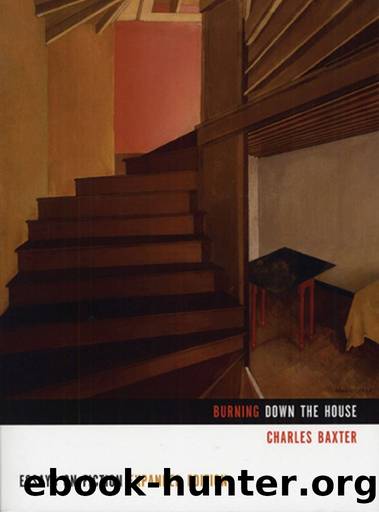Burning Down the House: Essays on Fiction by Charles Baxter

Author:Charles Baxter [Baxter, Charles]
Language: eng
Format: azw3
Tags: Essays, Literary Criticism, Nonfiction, Writing
ISBN: 9781555970956
Publisher: Graywolf Press
Published: 2013-07-15T23:00:00+00:00
In the act of dying, Quilty visually brings forth Lolita. There she is, her visual traceries coming out of his mouth. He has taken her innocence, and itâs inside him. The gum is still echoing there, but now itâs grown up, gone through adolescence, and become bloody. This is a small example of a visual rhyming effect, the transformation of an image from one person to another. What better proxy than Quilty, who is both a gummy and bloody boor, to bring this image back to us?
The first sentence of the last paragraph of James Joyceâs âThe Deadâ is a simple declarative statement: âA few light taps upon the pane made him turn to the window.â Itâs a seemingly innocent pronouncement, and it does not force itselfâor anything elseâupon us. But in the previous paragraph, Gabriel Conroy has imagined Michael Furey, a âyoung man standing under a dripping tree,â as a part of the âvast hosts of the deadâ whose region he is approaching. The next paragraph begins with those few light taps upon the pane.
The narration does not say that the taps are those of falling snow until the next sentence. If we stop at the end of the sentence, and if we bother to remember what Gretta Conroy has just told Gabriel, we will remember that Michael Furey used to announce himself to Gretta by flinging pebbles and stones against her windowpane. That sound has returned. We are hearing its echo. But this time it is brought to us by the snow, which Gabriel has introduced into the story from the moment he walked into his auntsâ house, scraping snow from his galoshes.
Weâre just far enough away from Grettaâs story so that we probably have forgotten those taps on the window. But here they are again. Although Michael Furey is dead, the same sound he created is present again at the window. All right: Itâs just the snow. By this time, however, the entire landscape has been transformed, so that we have entered the region of the past made manifestâthe return, not of the repressed, but of the missing and the lost.
In Sylvia Townsend Warnerâs story âOxenhope,â published in 1971, the protagonist, a man named William, returns by car to a place in the Midlands he visited on a walking tour when he was seventeen. He had taken the walking tour at that age because he felt his mind collapsing before the pressure of adulthood and the prospect of going to a university on a scholarship. The narration describes this condition as âbrain-mauling.â His mind had gone empty: âAll the facts he had grouped so tidily had dissolved into a broth stirred by an idiot.â In his walking tour, the boy chanced upon Oxenhope and was taken in by the woman of the house, who gave him milk and scones his first night there.
The first part of Sylvia Townsend Warnerâs story gives us his activities and his tasks during the month that the seventeen-year-old William stayed
Download
This site does not store any files on its server. We only index and link to content provided by other sites. Please contact the content providers to delete copyright contents if any and email us, we'll remove relevant links or contents immediately.
The Hating Game by Sally Thorne(17546)
The Universe of Us by Lang Leav(14400)
Sad Girls by Lang Leav(13378)
The Lover by Duras Marguerite(7150)
Smoke & Mirrors by Michael Faudet(5534)
The Rosie Project by Graeme Simsion(5218)
The Shadow Of The Wind by Carlos Ruiz Zafón(4963)
Big Little Lies by Liane Moriarty(4905)
The Poppy War by R. F. Kuang(4498)
Memories by Lang Leav(4185)
What Alice Forgot by Liane Moriarty(3935)
An Echo of Things to Come by James Islington(3877)
From Sand and Ash by Amy Harmon(3705)
The Poetry of Pablo Neruda by Pablo Neruda(3386)
The Tattooist of Auschwitz by Heather Morris(3277)
Guild Hunters Novels 1-4 by Nalini Singh(2949)
Ficciones by Jorge Luis Borges(2882)
THE ONE YOU CANNOT HAVE by Shenoy Preeti(2836)
The Rosie Effect by Graeme Simsion(2730)
